Seed Longevity in Desert Species and the Possibility of Forming a Persistent Soil Seed Bank
Abstract
1. Introduction
2. Materials and Methods
2.1. Seed Collection
2.2. Germination Trials
2.3. Data Analysis
3. Results
3.1. Seed Morphological Traits
3.2. Seed Germination
4. Discussion
5. Conclusions
Author Contributions
Funding
Institutional Review Board Statement
Informed Consent Statement
Data Availability Statement
Acknowledgments
Conflicts of Interest
References
- Chapman, T.; Miles, S.; Trivedi, C. Capturing, protecting and restoring plant diversity in the UK: RBG Kew and the Millennium Seed Bank. Plant Divers. 2019, 41, 124–131. [Google Scholar] [CrossRef]
- González-Alday, J.; Marrs, R.H.; Martínez-Ruiz, C. Soil seed bank formation during early revegetation after hydroseeding in reclaimed coal wastes. Ecol. Eng. 2009, 35, 1062–1069. [Google Scholar] [CrossRef]
- Mohammed, S.A.; Denboba, M.A. Study of soil seed banks in ex-closures for restoration of degraded lands in the central Rift Valley of Ethiopia. Sci. Rep. 2020, 10, 956. [Google Scholar] [CrossRef]
- Bossuyt, B.; Honnay, O. Can the seed bank be used for ecological restoration? An overview of seed bank characteristics in European communities. J. Veg. Sci. 2008, 19, 875–884. [Google Scholar] [CrossRef]
- Münzbergová, Z.; Šurinová, M.; Husáková, I.; Brabec, J. Strong fluctuations in aboveground population size do not limit genetic diversity in populations of an endangered biennial species. Oecologia 2018, 187, 863–872. [Google Scholar] [CrossRef]
- Basto, S.; Thompson, K.; Grime, J.P.; Fridley, J.D.; Calhim, S.; Askew, A.P. Severe effects of long-term drought on calcareous grassland seed banks. NPJ Clim. Atmospher. Sci. 2018, 1, 1. [Google Scholar] [CrossRef]
- Yang, X.; Baskin, C.C.; Baskin, J.M.; Pakeman, R.J.; Huang, Z.; Gao, R.; Cornelissen, J.H. Global patterns of potential future plant diversity hidden in soil seed banks. Nat. Commun. 2021, 12, 7023. [Google Scholar] [CrossRef] [PubMed]
- Funk, J.L. Revising the trait-based filtering framework to include interacting filters: Lessons from grassland restoration. J. Ecol. 2021, 109, 3466–3472. [Google Scholar] [CrossRef]
- Pake, C.E.; Venable, D.L. Seed banks in desert annuals: Implications for persistence and coexistence in variable environments. Ecology 1996, 77, 1427–1436. [Google Scholar] [CrossRef]
- Cabin, R.J.; Mitchell, R.J.; Marshall, D.L. Do surface plant and soil seed bank populations differ genetically? A multipopulation study of the desert mustard Lesquerella fendleri (Brassicaceae). Am. J. Bot. 1998, 85, 1098–1109. [Google Scholar] [CrossRef]
- Silvertown, J.; McConway, K.; Gowing, D.; Dodd, M.; Fay, M.F.; Joseph, J.A.; Dolphin, K. Absence of phylogenetic signal in the niche structure of meadow plant communities. Proc. R. Soc. B Biol. 2006, 273, 39–44. [Google Scholar] [CrossRef] [PubMed]
- Ooi, M.K.J. Seed bank persistence and climate change. Seed Sci. Res. 2012, 22, S53–S60. [Google Scholar] [CrossRef]
- Martens, B.; Waegeman, W.; Dorigo, W.A.; Verhoest, N.E.; Miralles, D.G. Terrestrial evaporation response to modes of climate variability. NPJ Clim. Atmos. Sci. 2018, 1, 43. [Google Scholar] [CrossRef]
- Abu Sukar, H.K.; Almerri, F.H.; Almurekki, A.A. Agro-Hydro-Meteorological Data Book for the State of Qatar, Doha. DAWR 2007. [Google Scholar]
- Rewald, B.; Leuschner, C.; Wiesman, Z.; Ephrath, J.E. Influence of salinity on root hydraulicproperties of three olive varieties. Plant Biosyst. 2011, 145, 12–22. [Google Scholar] [CrossRef]
- Wijayratne, U.C.; Pyke, D.A. Burial increases seed longevity of two Artemisia tridentata (Asteraceae) subspecies. Am. J. Bot. 2012, 99, 438–447. [Google Scholar] [CrossRef]
- Bhatt, A.; Gallacher, D.J.; Souza-Filho, P.R.M. Germination strategies of annual and short-lived perennial species in the Arabian Desert. J. Arid Land 2020, 12, 1071–1082. [Google Scholar] [CrossRef]
- Bhatt, A.; Bhat, N.R.; Phartyal, S.S.; Gallacher, D. Dry-storage and light exposure reduce dormancy of Arabian desert legumes more than temperature. Seed Sci. Technol. 2020, 48, 247–255. [Google Scholar] [CrossRef]
- Qiuyan, L.; Haiyan, F.; Qiangguo, C. Persistent soil seed banks along altitudinal gradients in the Qilian Mountains in China and their significance for conservation management. Afr. J. Agric. Res. 2011, 6, 2329–2340. [Google Scholar]
- Ernest, S.M.; Brown, J.H.; Parmenter, R.R. Rodents, plants, and precipitation: Spatial and temporal dynamics of consumers and resources. Oikos 2000, 88, 470–482. [Google Scholar] [CrossRef]
- Pol, R.G.; Pirk, G.I.; Marone, L. Grass seed production in the central Monte desert during successive wet and dry years. Plant Ecol. 2010, 208, 65–75. [Google Scholar] [CrossRef]
- Omar, S.; Roy, W.Y. Biodiversity and climate change in Kuwait. Int. J. Clim. Chang. Strateg. Manag. 2010, 2, 68–83. [Google Scholar] [CrossRef]
- Zhang, R.; Hu, X.; Baskin, J.M.; Baskin, C.C.; Wang, Y. Effects of litter on seedling emergence and seed persistence of three common species on the Loess Plateau in Northwestern China. Front. Plant Sci. 2017, 8, 103. [Google Scholar] [CrossRef]
- Thompson, K.; Band, S.R. Survival of a lowland heathland seed bank after a 33-year burial. Seed Sci. Res. 1997, 7, 409–411. [Google Scholar] [CrossRef]
- Long, R.L.; Gorecki, M.J.; Renton, M.; Scott, J.K.; Colville, L.; Goggin, D.E.; Commander, L.E.; Westcott, D.A.; Cherry, H.; Finch-Savage, W.E. The ecophysiology of seed persistence: A mechanistic view of the journey to germination or demise. Biol. Rev. 2015, 90, 31–59. [Google Scholar] [CrossRef]
- Ma, M.J.; Dalling, J.W.; Ma, Z.; Zhou, X.H. Soil environmental factors drive seed density across vegetation types on the Tibetan Plateau. Plant Soil. 2017, 419, 349–361. [Google Scholar] [CrossRef]
- Joet, T.; Ourcival, J.M.; Dussert, S. Ecological significance of seed desiccation sensitivity in Quercus ilex. Ann. Bot. 2013, 111, 693–701. [Google Scholar] [CrossRef]
- Tweddle, J.C.; Dickie, J.B.; Baskin, C.C.; Baskin, J.M. Ecological aspects of seed desiccation sensitivity. J. Ecol. 2003, 91, 294–304. [Google Scholar] [CrossRef]
- Murdoch, A.J.; Ellis, R.H. Dormancy, viability and longevity. In Seeds: The Ecology of Regeneration in Plant Communities; Fenner, M., Ed.; CAB International: Wallingford, UK, 2000; pp. 183–214. [Google Scholar]
- Berjak, P.; Pammenter, N.W. From Avicennia to Zizania: Seed recalcitrance in perspective. Ann. Bot. 2008, 101, 213–228. [Google Scholar] [CrossRef]
- Bhatt, A.; Bhat, N.R.; Murru, V.; Santo, A. Eco-physiological studies on desert plants: Germination of Halothamnus iraqensis Botsch. Seeds under different conditions. J. Arid Land 2019, 11, 75–85. [Google Scholar]
- Bhatt, A.; Bhat, N.R.; Suleiman, M.K.; Santo, A. Effects of storage, mucilage presence, photoperiod, thermoperiod and salinity on germination of Farsetia aegyptia Turra (Brassicaceae) seeds: Implications for restoration and seed banks in Arabian Desert. Plant Biosyst. 2019, 153, 280–287. [Google Scholar] [CrossRef]
- Bhatt, A.; Carón, M.M.; Gallacher, D.; Souza-Filho, P.R.M. Storage duration, light, temperature and salinity exposure influence germination of the glycophyte Rhanterium epapposum. Botany 2021, 99, 261–267. [Google Scholar] [CrossRef]
- Al-Jaloud, A.A.; Chaudhary, S.A.; Bashour, I.I.; Qureshit, S.; Al-Shanghitti, A. Nutrient evaluation of some arid range plants in Saudi Arabia. J. Arid Environ. 1994, 28, 299–311. [Google Scholar] [CrossRef]
- Elgamal, M.H.A.; Soliman, H.S.; Karawya, M.S.; Mikhova, B.; Duddeck, H. Isolation of triterpene saponins from Gypsophila capillaris. Phytochemistry 1995, 38, 1481–1485. [Google Scholar] [CrossRef]
- Omar, S.; Zaman, S. Kuwait rangelands status, development and research priorities. Sustain. Dev. Arid Zones 1998, 2, 403–421. [Google Scholar]
- Bidak, L.M.; Kamal, S.A.; Halmy, M.W.A.; Heneidy, S.Z. Goods and services provided by native plants in desert ecosystems: Examples from the northwestern coastal desert of Egypt. Glob. Ecol. Conserv. 2015, 3, 433–447. [Google Scholar] [CrossRef]
- Akhter, R.; Arshad, M. Arid rangelands in the Cholistan desert (Pakistan). Sci. Chang. Planétaires Sécheresse 2006, 17, 210–217. [Google Scholar]
- Rafay, M.; Khan, R.A.; Yaqoob, S.; Ahmad, M. Floristic composition of grass species in the degrading rangelands of Cholistan desert. Pak. J. Agric. Sci. 2013, 50, 599–603. [Google Scholar]
- Omar, S.; Al-Mutawa, Y.; Zaman, S. Vegetation of Kuwait; Kuwait Institute for Scientific Research: Kuwait City, Kuwait, 2007. [Google Scholar]
- Bush, E.W.; Wilson, P.; Shepard, D.P.; McClure, G. Enhancement of Seed Germination in Common Carpet Grass and Centipede Grass Seed. HortScience 2000, 35, 769–770. [Google Scholar] [CrossRef]
- Milberg, P.; Andersson, L.; Thompson, K. Large-seeded spices are less dependent on light for germination than small-seeded ones. Seed Sci. Res. 2000, 10, 99–104. [Google Scholar] [CrossRef]
- Viegi, L.; Pieroni, A.; Guarrera, P.M.; Vangelisti, R. A review of plants used in folk veterinary medicine in Italy as basis for a databank. J. Ethnopharmacol. 2003, 89, 221–244. [Google Scholar] [CrossRef] [PubMed]
- Calderoni, M.; Altare, M.; Mastracci, L.; Grillo, F.; Cornara, L.; Pagano, A. Potential risks of plant constituents in dietary supplements: Qualitative and quantitative analysis of Peganum harmala seeds. Molecules 2021, 26, 1368. [Google Scholar] [CrossRef]
- Amartuvshin, N.; Dariimaa, S.; Tserenbaljid, G. Taxonomy of the genus Peganum L. (Peganaceae VAN TIEGHEM) in Mongolia. Mong. J. Biol. Sci. 2006, 4, 9–13. [Google Scholar]
- Danin, A. Plant adaptations to environmental stresses in desert dunes. Plants Desert Dunes 1996, 7, 133–152. [Google Scholar]
- Ghazanfar, S.A.; Böer, B.; Al Khulaidi, A.W.; El-Keblawy, A.; Alateeqi, S. Plants of Sabkha ecosystems of the Arabian Peninsula. Sabkha Ecosyst. 2019, VI, 55–80. [Google Scholar]
- Smith, N.M. Weeds of the Wet/Dry Tropics of Australia—A Field Guide; Environment Centre NT, Inc.: Darwin, Australia, 2002; p. 112. [Google Scholar]
- Mifsud, S. Update on Maltese flora (Central Mediterranean) including very rare species thought to be extinct from mainland Malta or its islands. Cent. Mediterr. Nat. 2009, 5, 7–16. [Google Scholar]
- Moles, A.T.; Ackerly, D.D.; Webb, C.O.; Tweddle, J.C.; Dickie, J.B.; Westoby, M. A brief history of seed size. Science 2005, 307, 576–580. [Google Scholar] [CrossRef]
- Baskin, C.C.; Baskin, J.M. Seeds: Ecology, Biogeography, and Evolution of Dormancy and Germination, 2nd ed.; Elsevier: Amsterdam, The Netherlands; Academic Press: San Diego, CA, USA, 2014. [Google Scholar]
- Nolan, D.G.; Upadhyaya, M.K. Primary seed dormancy in diffuse and spotted knapweed. Can. J. Plant Sci. 1988, 68, 775–783. [Google Scholar] [CrossRef]
- El-Keblawy, A. Impacts of dormancy regulating chemicals on innate and salinity-induced dormancy of four forage grasses native to Arabian deserts. Grass Forage Sci. 2013, 68, 288–296. [Google Scholar] [CrossRef]
- Yi, F.; Wang, Z.; Baskin, C.C.; Baskin, J.M.; Ye, R.; Sun, H.; Huang, Z. Seed germination responses to seasonal temperature and drought stress are species-specific but not related to seed size in a desert steppe: Implications for effect of climate change on community structure. Ecol. Evol. 2019, 9, 2149–2159. [Google Scholar] [CrossRef] [PubMed]
- El-Keblawy, A.; Shaltout, K.H.; Lovett-Doust, J.; Ramadan, A. Population dynamic of an Egyptian desert shrub, Thymelaea hirsuta. Can. J. Plant Sci. 1997, 75, 2027–2037. [Google Scholar] [CrossRef]
- Bhatt, A.; Gairola, S.; El-Keblawy, A.A. Seed colour affects light and temperature requirements during germination in two Lotus species (Fabaceae) of the Arabian subtropical deserts. Rev. Biol. Trop. 2016, 64, 483–492. [Google Scholar] [CrossRef] [PubMed]
- Ottewell, K.M.; Bickerton, D.; Lowe, A.J. Can a seed bank provide demographic and genetic rescue in a declining population of the endangered shrub Acacia pinguifolia? Conserv. Genet. 2011, 12, 669–678. [Google Scholar] [CrossRef]
- Abeli, T.; Dixon, K. Translocation ecology: The role of ecological sciences in plant translocation. Plant Ecol. 2016, 217, 123–125. [Google Scholar] [CrossRef][Green Version]
- Sano, N.; Rajjou, L.; North, H.M.; Debeaujon, I.; Marion-Poll, A.; Seo, M. Staying alive: Molecular aspects of seed longevity. Plant Cell Physiol. 2016, 57, 660–674. [Google Scholar] [CrossRef] [PubMed]
- Stavrinides, A.K.; Dussert, S.; Combes, M.C.; Fock-Bastide, I.; Severac, D.; Minier, J.; Joët, T. Seed comparative genomics in three coffee species identify desiccation tolerance mechanisms in intermediate seeds. J. Exp. Bot. 2020, 71, 1418–1433. [Google Scholar] [CrossRef] [PubMed]
- Sallon, S.; Solowey, E.; Cohen, Y.; Korchinsky, R.; Egli, M.; Woodhatch, I.; Kislev, M. Germination, genetics, and growth of an ancient date seed. Science 2008, 320, 1464. [Google Scholar] [CrossRef]
- Groot, S.; Surki, A.A.; Vos, R.; Kodde, J. Seed storage at elevated partial pressure of oxygen, a fast method for analysing seed ageing under dry conditions. Ann. Bot. 2012, 110, 1149–1159. [Google Scholar] [CrossRef]
- Righetti, K.; Ly Vu, J.; Pelletier, S.; Ly Vu, B.; Glaab, E.; Lalanne, D.; Pasha, A.; Patel, R.V.; Provart, N.J.; Verdier, J.; et al. Inference of longevity-related genes from a robust co-expression network of seed maturation identifies new regulators linking seed storability to biotic defense-related pathways. Plant Cell 2015, 27, 2692–2708. [Google Scholar] [PubMed]
- Walck, J.L.; Hidayati, S.N.; Dixon, K.W.; Thompson, K.E.N.; Poschlod, P. Climate change and plant regeneration from seed. Glob. Chang. Biol. 2011, 17, 2145–2161. [Google Scholar] [CrossRef]
- Liu, H.; Abudureheman, B.; Zhang, L.; Baskin, J.M.; Baskin, C.C.; Zhang, D. Seed dormancy-breaking in a cold desert shrub in relation to sand temperature and moisture. AoB Plants 2017, 9, plx003. [Google Scholar] [CrossRef]
- Commander, L.E.; Merritt, D.J.; Rokich, D.P.; Dixon, K.W. The role of after-ripening in promoting germination of arid zone seeds: A study on six Australian species. Bot. J. Linn. Soc. 2009, 161, 411–421. [Google Scholar] [CrossRef][Green Version]
- Jaganathan, G.K.; Yule, K.J.; Biddick, M. Determination of the water gap and the germination ecology of Adenanthera pavonine (Fabaceae, Mimosoideae); the adaptive role of physical dormancy in mimetic seeds. AoB Plants 2018, 10, ply048. [Google Scholar] [CrossRef] [PubMed]
- Jaganathan, G.K.; Biddick, M. Experimental warming hastens physical dormancy break and germination in tropical Fabaceae. Front. Plant Sci. 2021, 12, 782706. [Google Scholar] [CrossRef]
- Finch-Savage, W.E.; Leubner-Metzger, G. Seed dormancy and the control of germination. New Phytol. 2006, 171, 501–523. [Google Scholar] [CrossRef] [PubMed]
- Saatkamp, A.; Affre, L.; Dutoit, T.; Poschlod, P. Germination traits explain soil seed persistence across species: The case of Mediterranean annual plants in cereal fields. Ann. Bot. 2011, 107, 415–426. [Google Scholar] [CrossRef]
- Scopel, A.L.; Ballaré, C.L.; Sánchez, R.A. Induction of extreme light sensitivity in buried weed seeds and its role in the perception of soil cultivations. Plant Cell Environ. 1991, 14, 501–508. [Google Scholar] [CrossRef]
- Casal, J.J.; Sánchez, R.A. Phytochromes and seed germination. Seed Sci. Res. 1998, 8, 317–329. [Google Scholar] [CrossRef]
- Silva, L.M.; Fernandes, G.W. Effect of seed storage on germination, seedling growth and survival of Mimosa foliolosa (Fabaceae): Implications for seed banks and restoration ecology. Trop. Ecol. 2014, 55, 385–392. [Google Scholar]
- Rühl, A.T.; Eckstein, R.L.; Otte, A. Distinct germination response of endangered and common arable weeds to reduced water potential. Plant Biol. 2016, 218, 83–90. [Google Scholar] [CrossRef]
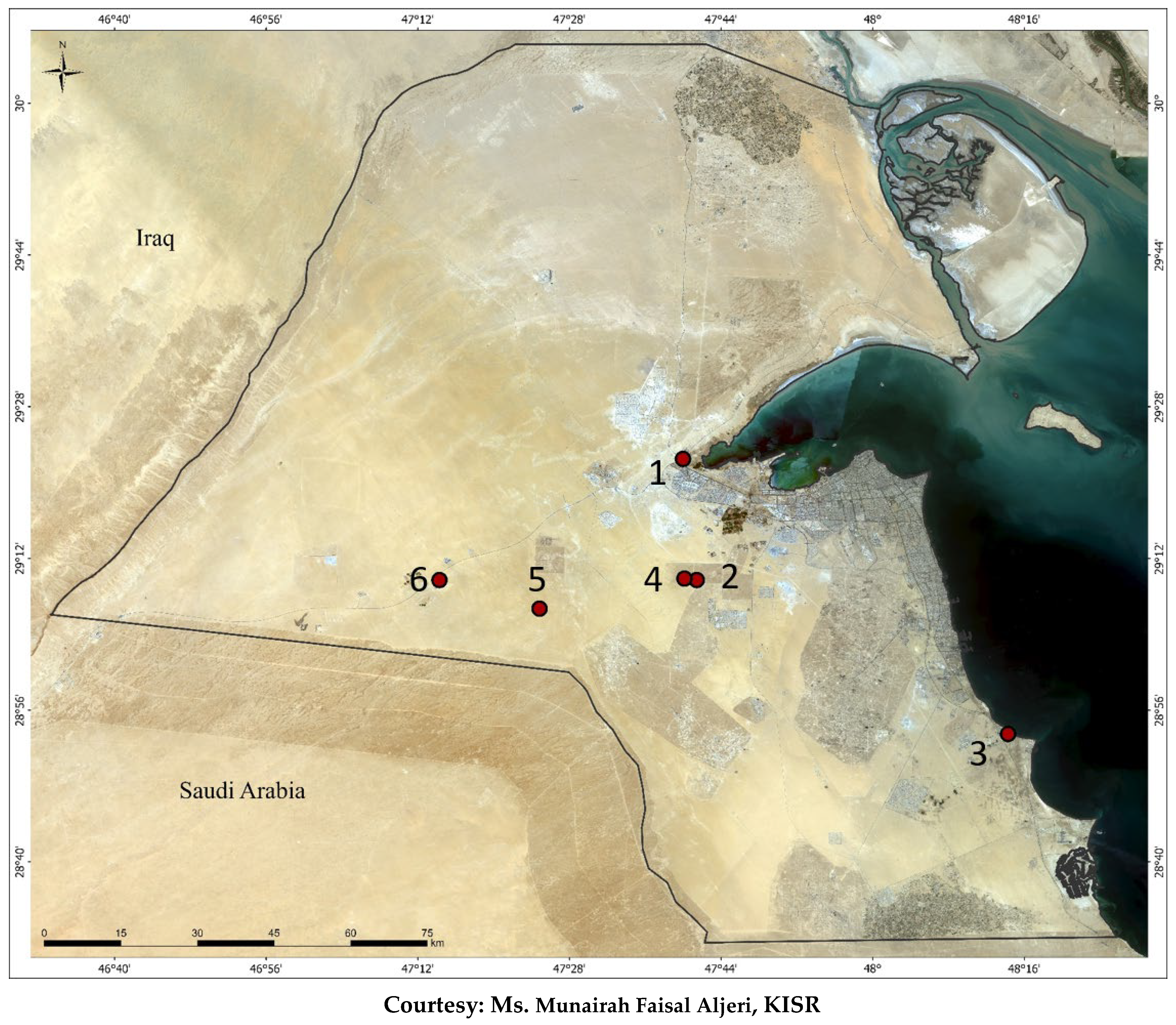
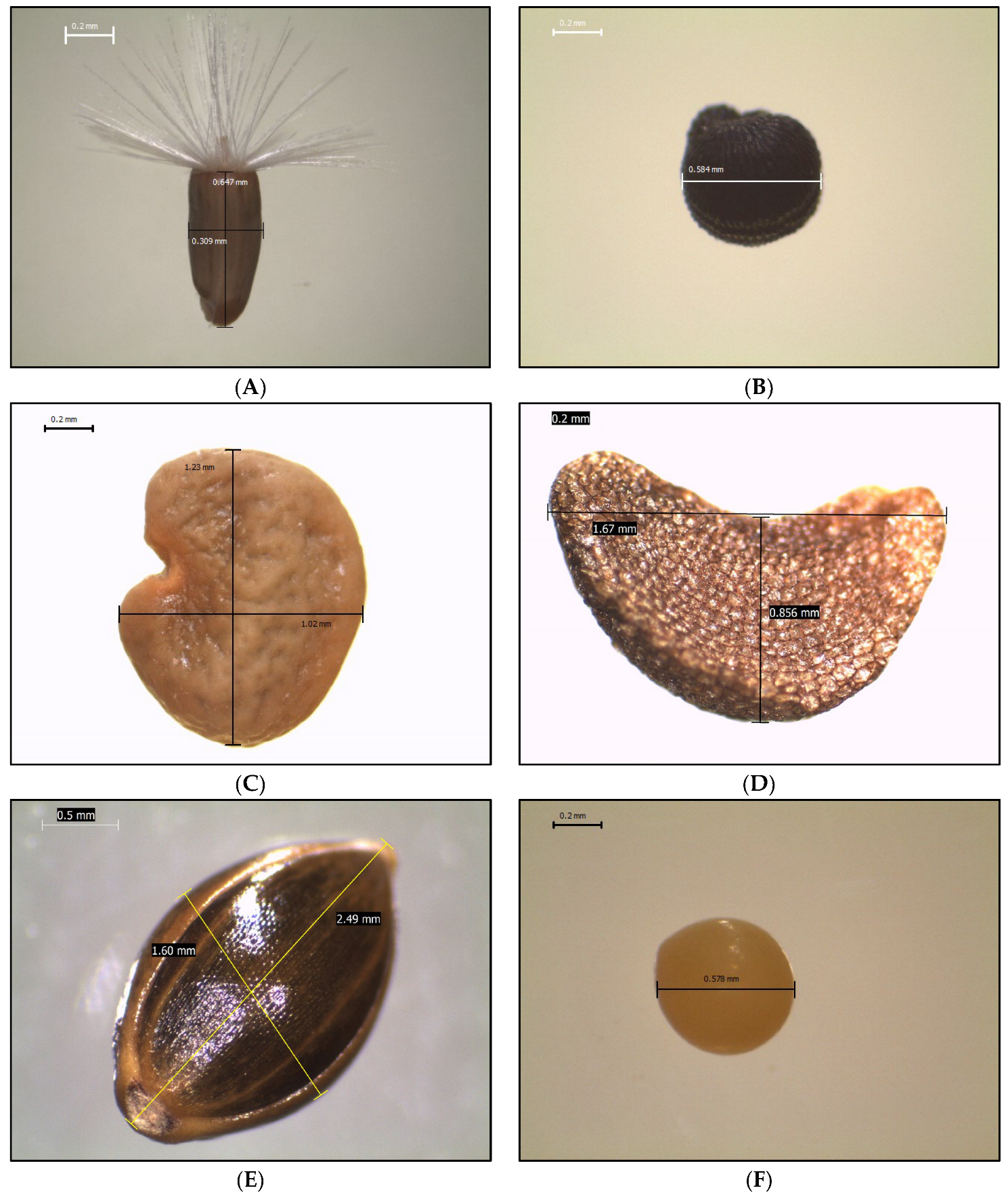
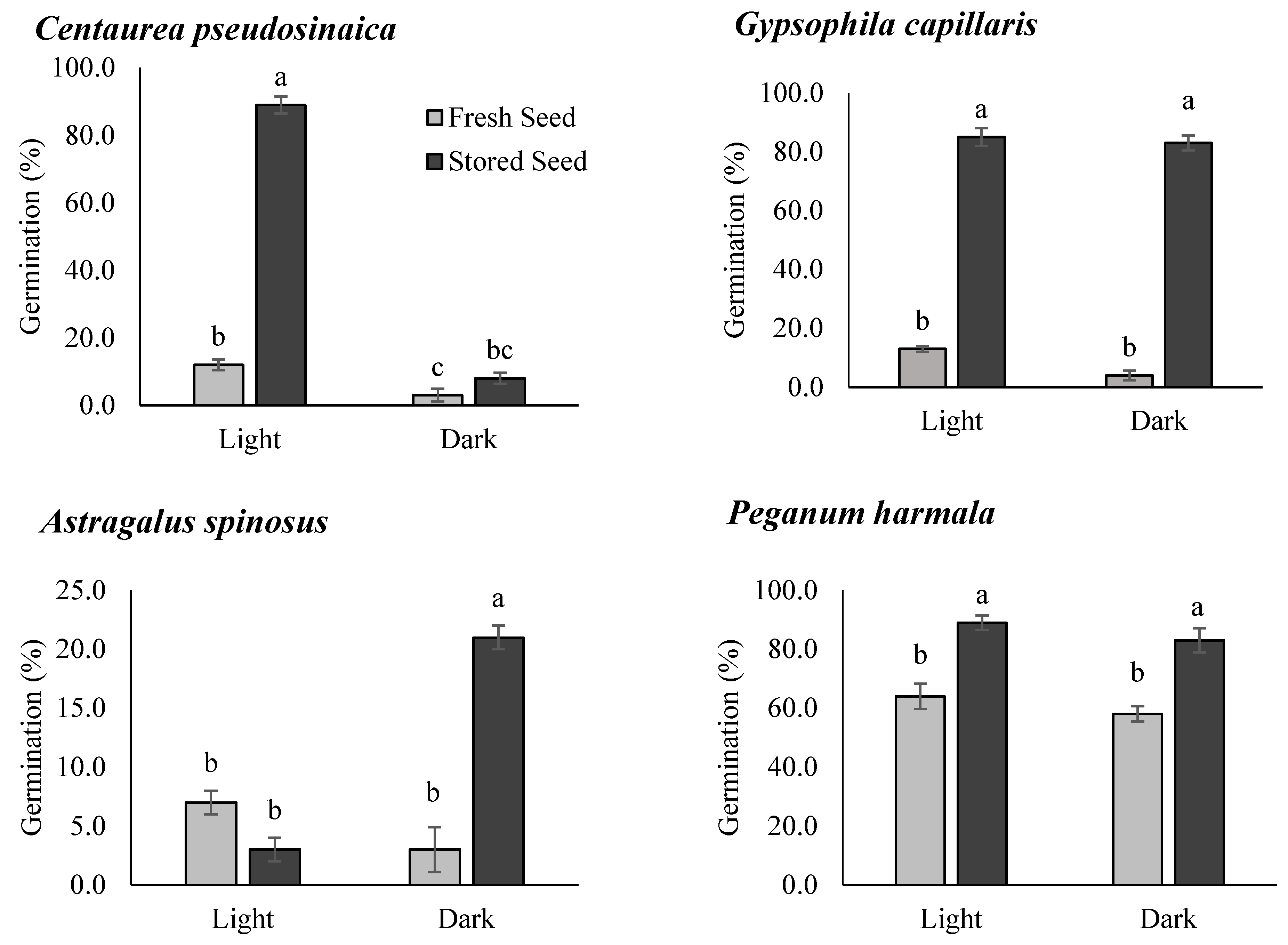
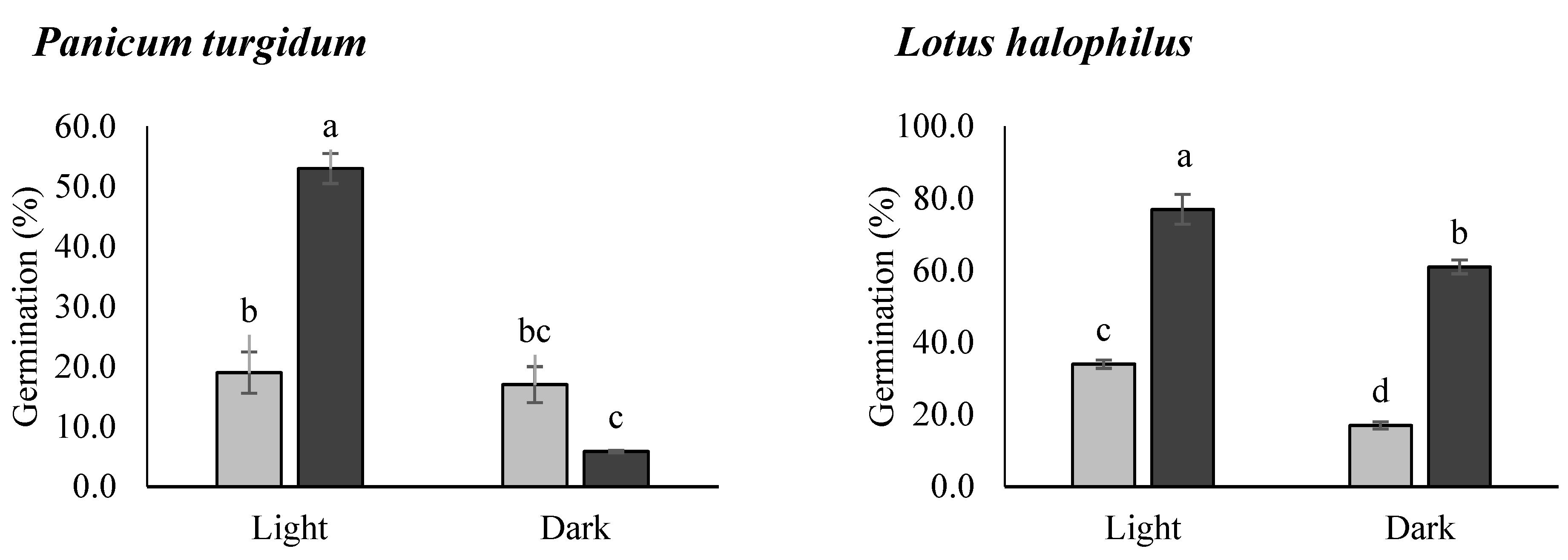
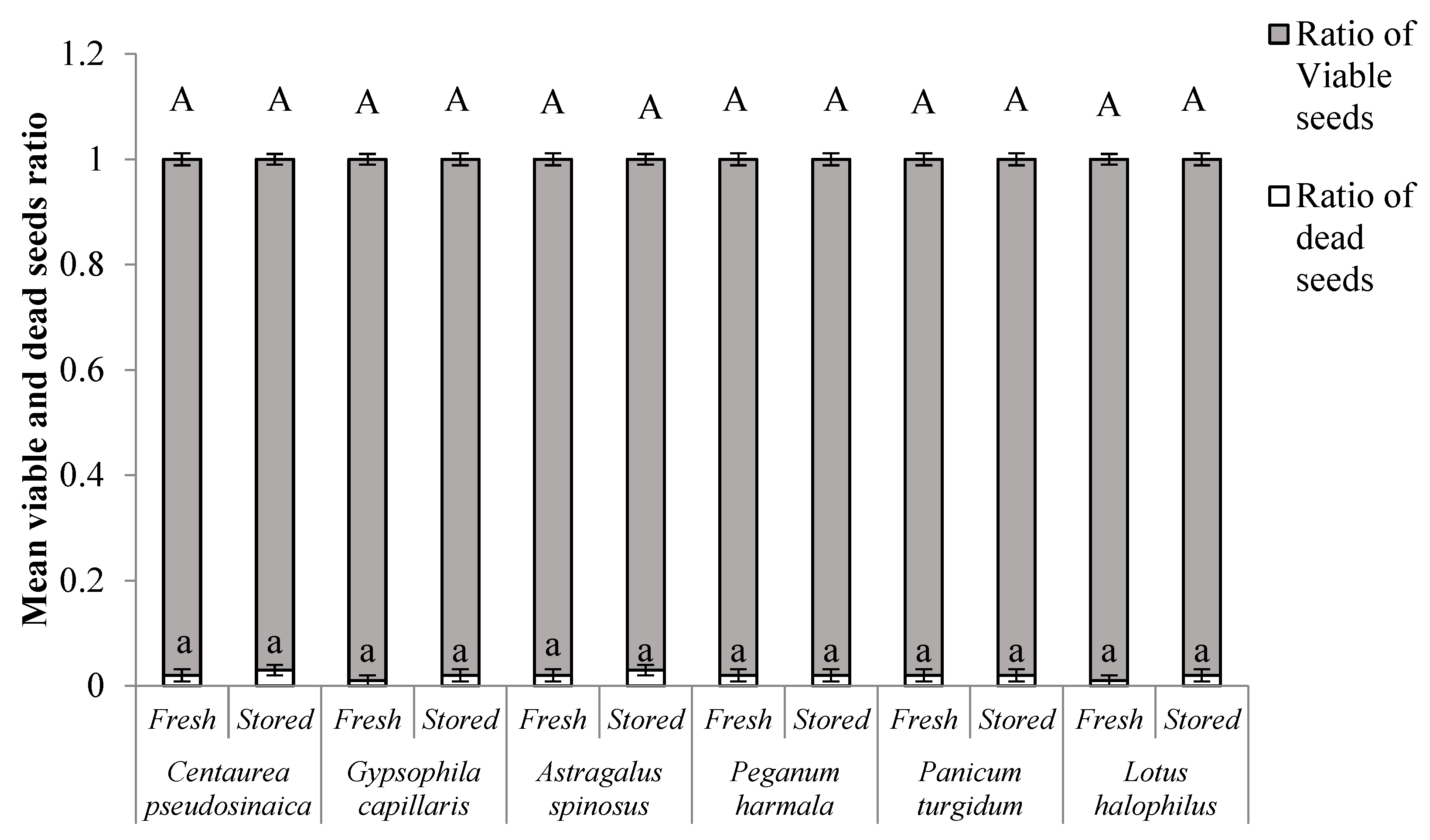
| Species | Family | Collection Month (2017) and Location | Uses | References |
|---|---|---|---|---|
| Centaurea pseudosinaica Czerep | Asteraceae | June, Mutla, 29°22′29.01″ N, 47°39′59.62″ E | Fo | [34] |
| Gypsophila capillaris (Forsk.) C. Chr | Caryophyllaceae | May, Sulaibia 29°09′44″ N, 47°41′26″ E | M, Fo | [35,36] |
| Astragalus spinosus Vahl | Fabaceae | May, Julaia 28°53′29.46″ N, 48°14′17.21″ E | M, Fo, Fu, Ss | [37] |
| Peganum harmala L. | Zygophyllaceae | June, Sulaibia 29°09′50″ N, 47°41′05″ E | M, Ss | [37] |
| Panicum turgidum Forssk | Poaceae | June, Sulaibia, 29°06′43″ N, 47°24′51″ E | F, Ss | [38,39] |
| Lotus halophilus Boiss and Spruner | Fabaceae | May, Sulaibia 29°09′44″ N, 47°14′17.21″ E | M, Fo, Fu, Ss | [37] |
| Species | Life Form | Seed Color | Seed Shape | Dispersal Mode * | Seed Mass ± SE | Reference * |
|---|---|---|---|---|---|---|
| C. pseudosinaica | A | Grey/brown | Oblong-inflated | Anemochory | 527.4 ± 62.0 | [43] |
| G. capillaris | A | Black | Reniform | Unassisted | 160.0 ± 5.2 | |
| A. spinosus | P | Brown | Reniform | Unassisted | 294.0 ± 4.2 | |
| P. harmala | P | Brown | Triangular | Anemochory/Zoochory | 120.8 ± 0.9 | [44,45] |
| P. turgidum | P | Black | Ovate | Anemochory | 135.7 ± 3.5 | [46,47] |
| L. halophilus | A | Yellow | Suborbicular | Hydrochory/Zoochory | 100.9 ± 0.5 | [48,49] |
| Factor | Photoperiod (P) | Storage (S) | P × S |
|---|---|---|---|
| Centaurea pseudosinaica | 0.025 | <0.001 | 0.013 |
| Gypsophila capillaris | 0.031 | <0.001 | 0.11 |
| Astragalus spinosus | 0.207 | <0.001 | 0.884 |
| Peganum harmala | 0.385 | <0.001 | 0.619 |
| Panicum turgidum | 0.713 | <0.001 | 0.567 |
| Lotus halophilus | 0.007 | <0.001 | 0.727 |
| Species | RLG Index | |
|---|---|---|
| Fresh Seed | Stored Seed | |
| Centaurea pseudosinaica | 0.838 ± 0.09 a | 0.809 ± 0.01 a |
| Gypsophila capillaris | 0.775 ± 0.08 a | 0.506 ± 0.01 b |
| Astragalus spinosus | 0.792 ± 0.13 a | 0.666 ± 0.01 a |
| Peganum harmala | 0.523 ± 0.03 a | 0.518 ± 0.01 a |
| Panicum turgidum | 0.525 ± 0.06 a | 0.553 ± 0.01 a |
| Lotus halophilus | 0.667 ± 0.01 a | 0.557 ± 0.02 b |
| Species | Mean Time for Germination (MGT) ± SD | |
|---|---|---|
| Fresh | Stored | |
| Centaurea pseudosinaica | 7.0 ± 0.7 a | 2.8 ± 0.2 b |
| Gypsophila capillaris | 7.8 ± 0.7 a | 4.5 ± 0.4 b |
| Astragalus spinosus | 3.6 ± 1.6 a | 3.4 ± 0.6 a |
| Peganum harmala | 4.4 ± 0.6 a | 3.9 ± 0.1 a |
| Panicum turgidum | 5.2 ± 0.8 a | 5.8 ± 0.4 a |
| Lotus halophilus | 4.4 ± 0.4 a | 2.1 ± 0.2 b |
Disclaimer/Publisher’s Note: The statements, opinions and data contained in all publications are solely those of the individual author(s) and contributor(s) and not of MDPI and/or the editor(s). MDPI and/or the editor(s) disclaim responsibility for any injury to people or property resulting from any ideas, methods, instructions or products referred to in the content. |
© 2023 by the authors. Licensee MDPI, Basel, Switzerland. This article is an open access article distributed under the terms and conditions of the Creative Commons Attribution (CC BY) license (https://creativecommons.org/licenses/by/4.0/).
Share and Cite
Suleiman, M.K.; Bhatt, A.; Jacob, S.; Thomas, R.R.; Sivadasan, M.T. Seed Longevity in Desert Species and the Possibility of Forming a Persistent Soil Seed Bank. Sustainability 2023, 15, 15904. https://doi.org/10.3390/su152215904
Suleiman MK, Bhatt A, Jacob S, Thomas RR, Sivadasan MT. Seed Longevity in Desert Species and the Possibility of Forming a Persistent Soil Seed Bank. Sustainability. 2023; 15(22):15904. https://doi.org/10.3390/su152215904
Chicago/Turabian StyleSuleiman, Majda K., Arvind Bhatt, Sheena Jacob, Rini R. Thomas, and Mini T. Sivadasan. 2023. "Seed Longevity in Desert Species and the Possibility of Forming a Persistent Soil Seed Bank" Sustainability 15, no. 22: 15904. https://doi.org/10.3390/su152215904
APA StyleSuleiman, M. K., Bhatt, A., Jacob, S., Thomas, R. R., & Sivadasan, M. T. (2023). Seed Longevity in Desert Species and the Possibility of Forming a Persistent Soil Seed Bank. Sustainability, 15(22), 15904. https://doi.org/10.3390/su152215904






